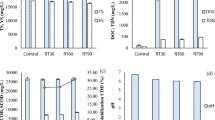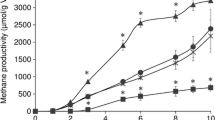Abstract
The impact of antibiotics on the environmental protection and sludge treatment fields has been widely studied. The recovery of hydrogen from waste activated sludge (WAS) has become an issue of great interest. Nevertheless, few studies have focused on the impact of antibiotics present in WAS on hydrogen production during dark anaerobic fermentation. To explore the mechanisms, sulfamethoxazole (SMX) was chosen as a representative antibiotic to evaluate how SMX influenced hydrogen production during dark anaerobic fermentation of WAS. The results demonstrated SMX promoted hydrogen production. With increasing additions of SMX from 0 to 500 mg/kg TSS, the cumulative hydrogen production elevated from 8.07 ± 0.37 to 11.89 ± 0.19 mL/g VSS. A modified Gompertz model further verified that both the maximum potential of hydrogen production (Pm) and the maximum rate of hydrogen production (Rm) were promoted. SMX did not affected sludge solubilization, but promoted hydrolysis and acidification processes to produce more hydrogen. Moreover, the methanogenesis process was inhibited so that hydrogen consumption was reduced. Microbial community analysis further demonstrated that the introduction of SMX improved the abundance of hydrolysis bacteria and hydrogen-volatile fatty acids (VFAs) producers. SMX synergistically influenced hydrolysis, acidification and acetogenesis to facilitate the hydrogen production.

Similar content being viewed by others
References
Budiman P M, Wu T Y (2018). Role of chemicals addition in affecting biohydrogen production through photofermentation. Energy Conversion and Management, 165: 509–527
Cai M, Liu J, Wei Y (2004). Enhanced biohydrogen production from sewage sludge with alkaline pretreatment. Environmental Science & Technology, 38(11): 3195–3202
Chen H, Zeng X, Zhou Y, Yang X, Lam S S, Wang D (2020). Influence of roxithromycin as antibiotic residue on volatile fatty acids recovery in anaerobic fermentation of waste activated sludge. Journal of Hazardous Materials, 394: 122570–122580
Gao Y, Zhao J, Qin C, Yuan Q, Zhu J, Sun Y, Lu C (2021). Evaluating the effect of fluoxetine on mesophilic anaerobic dark biohydrogen fermentation of excess sludge. Bioresource Technology, 336: 125320
Hahnke S, Langer T, Klocke M (2018). Proteiniborus indolifex sp. nov., isolated from a thermophilic industrial-scale biogas plant. International Journal of Systematic and Evolutionary Microbiology, 68(3): 824–828
Hu J, Zhao J, Wang D, Li X, Zhang D, Xu Q, Peng L, Yang Q, Zeng G (2018a). Effect of diclofenac on the production of volatile fatty acids from anaerobic fermentation of waste activated sludge. Bioresource Technology, 254: 7–15
Huang C, Tang Z, Xi B, Tan W, Guo W, Wu W, Ma C (2021). Environmental effects and risk control of antibiotic resistance genes in the organic solid waste aerobic composting system: a review. Frontiers of Environmental Science & Engineering, 15(6): 127
Izadi P, Schröder U (2022). What is the role of individual species within bidirectional electroactive microbial biofilms: A case study on Desulfarculus baarsii and Desulfurivibrio alkaliphilus. ChemElectroChem, 9(2): 202101116–202101125
Kristiansen R, Nguyen H T, Saunders A M, Nielsen J L, Wimmer R, Le V Q, McIlroy S J, Petrovski S, Seviour R J, Calteau A, Nielsen K L, Nielsen P H (2013). A metabolic model for members of the genus Tetrasphaera involved in enhanced biological phosphorus removal. ISME Journal, 7(3): 543–554
Li X, Sui K, Zhang J, Liu X, Xu Q, Wang D, Yang Q (2022). Revealing the mechanisms of rhamnolipid enhanced hydrogen production from dark fermentation of waste activated sludge. Science of the Total Environment, 806(Pt 1): 150347
Lu L, Xing D, Ren N (2012). Pyrosequencing reveals highly diverse microbial communities in microbial electrolysis cells involved in enhanced H2 production from waste activated sludge. Water Research, 46(7): 2425–2434
Oberoi A S, Jia Y, Zhang H, Khanal S K, Lu H (2019). Insights into the fate and removal of antibiotics in engineered biological treatment systems: a critical review. Environmental Science & Technology, 53(13): 7234–7264
Qi N, Hu X, Zhao X, Li L, Yang J, Zhao Y, Li X (2018). Fermentative hydrogen production with peanut shell as supplementary substrate: effects of initial substrate, pH and inoculation proportion. Renewable Energy, 127: 559–564
Schmidt T, McCabe B K, Harris P W, Lee S (2018). Effect of trace element addition and increasing organic loading rates on the anaerobic digestion of cattle slaughterhouse wastewater. Bioresource Technology, 264: 51–57
Tong C, Xiao D, Xie L, Yang J, Zhao R, Hao J, Huo Z, Zeng Z, Xiong W (2022). Swine manure facilitates the spread of antibiotic resistome including tigecycline-resistant eet(X) variants to farm workers and receiving environment. Science of the Total Environment, 808: 152157–152168
Wang B, Ji S Q, Tian X X, Qu L Y, Li F L (2015). Brassicibacter thermophilus sp. nov., a thermophilic bacterium isolated from coastal sediment. International Journal of Systematic and Evolutionary Microbiology, 65(9): 2870–2874
Wang D, Duan Y, Yang Q, Liu Y, Ni B J, Wang Q, Zeng G, Li X, Yuan Z (2018a). Free ammonia enhances dark fermentative hydrogen production from waste activated sludge. Water Research, 133: 272–281
Wang D, Liu B, Liu X, Xu Q, Yang Q, Liu Y, Zeng G, Li X, Ni B J (2018b). How does free ammonia-based sludge pretreatment improve methane production from anaerobic digestion of waste activated sludge. Chemosphere, 206: 491–501
Wang D, Shuai K, Xu Q, Liu X, Li Y, Liu Y, Wang Q, Li X, Zeng G, Yang Q (2018c). Enhanced short-chain fatty acids production from waste activated sludge by combining calcium peroxide with free ammonia pretreatment. Bioresource Technology, 262: 114–123
Wang G, Jin Z, Wang X, George T S, Feng G, Zhang L (2022a). Simulated root exudates stimulate the abundance of Saccharimonadales to improve the alkaline phosphatase activity in maize rhizosphere. Applied Soil Ecology, 170: 104274–104284
Wang H, Guo W, Yin R, Du J, Wu Q, Luo H, Liu B, Sseguya F, Ren N (2019a). Biochar-induced Fe(III) reduction for persulfate activation in sulfamethoxazole degradation: insight into the electron transfer, radical oxidation and degradation pathways. Chemical Engineering Journal, 362: 561–569
Wang L, Yang C, Thangavel S, Guo Z, Chen C, Wang A, Liu W (2021). Enhanced hydrogen production in microbial electrolysis through strategies of carbon recovery from alkaline/thermal treated sludge. Frontiers of Environmental Science & Engineering, 15(4): 56
Wang Y, Wang D, Chen F, Yang Q, Li Y, Li X, Zeng G (2019b). Effect of triclocarban on hydrogen production from dark fermentation of waste activated sludge. Bioresource Technology, 279: 307–316
Wang Y, Zheng K, Guo H, Tong Y, Zhu T, Liu Y (2022b). Unveiling the mechanisms of how vivianite affects anaerobic digestion of waste activated sludge. Bioresource Technology, 343: 126045
Wei Y, Zhou A, Duan Y, Liu Z, He Z, Zhang J, Liang B, Yue X (2022). Unraveling the behaviors of sulfonamide antibiotics on the production of short-chain fatty acids by anaerobic fermentation from waste activated sludge and the microbial ecological mechanism. Chemosphere, 296: 133903–133911
Wu S L, Luo G, Sun J, Wei W, Song L, Ni B J (2021). Medium chain fatty acids production from anaerobic fermentation of waste activated sludge. Journal of Cleaner Production, 279: 123482–123492
Wu Y, Wang D, Liu X, Xu Q, Chen Y, Yang Q, Li H, Ni B (2019). Effect of poly aluminum chloride on dark fermentative hydrogen accumulation from waste activated sludge. Water Research, 153: 217–228
Xie J, Duan X, Feng L, Yan Y, Wang F, Dong H, Jia R, Zhou Q (2019). Influence of sulfadiazine on anaerobic fermentation of waste activated sludge for volatile fatty acids production: Focusing on microbial responses. Chemosphere, 219: 305–312
Yan T, Yang Q, Feng R, Ren X, Zhao Y, Sun M, Yan L, Wei Q (2022). Highly effective visible-photocatalytic hydrogen evolution and simultaneous organic pollutant degradation over an urchin-like oxygen-doped MoS2/ZnIn2S4 composite. Frontiers of Environmental Science & Engineering, 16(10): 131
Yang G, Wang J (2021). Enhancing biohydrogen production from disintegrated sewage sludge by combined sodium citrate-thermal pretreatment. Journal of Cleaner Production, 312: 127756–127765
Yang L, Li K, Cui S, Kang Y, An L, Lei K (2019). Removal of microplastics in municipal sewage from China’s largest water reclamation plant. Water Research, 155: 175–181
Zeng S, Sun J, Chen Z, Xu Q, Wei W, Wang D, Ni B J (2021). The impact and fate of clarithromycin in anaerobic digestion of waste activated sludge for biogas production. Environmental Research, 195: 110792
Zhao J, Wang D, Liu Y, Ngo H H, Guo W, Yang Q, Li X (2018). Novel stepwise pH control strategy to improve short chain fatty acid production from sludge anaerobic fermentation. Bioresource Technology, 249: 431–438
Zhao Q, Guo W, Luo H, Xing C, Wang H, Liu B, Si Q, Li D, Sun L, Ren N (2022). Insights into removal of sulfonamides in anaerobic activated sludge system: Mechanisms, degradation pathways and stress responses. Journal of Hazardous Materials, 423(B): 127248–127261
Zhao Y, Chen Y, Zhang D, Zhu X (2010). Waste activated sludge fermentation for hydrogen production enhanced by anaerobic process improvement and acetobacteria inhibition: the role of fermentation pH. Environmental Science & Technology, 44(9): 3317–3323
Zhu T, Zhang Y, Bu G, Quan X, Liu Y (2016). Producing nitrite from anodic ammonia oxidation to accelerate anammox in a bioelectrochemical system with a given anode potential. Chemical Engineering Journal, 291: 184–191
Zhu T T, Cheng H Y, Yang L H, Su S G, Wang H C, Wang S S, Wang A J (2019). Coupled sulfur and iron(II) carbonate-driven autotrophic denitrification for significantly enhanced nitrate removal. Environmental Science & Technology, 53(3): 1545–1554
Zhu T T, Su Z X, Lai W X, Zhang Y B, Liu Y W (2021). Insights into the fate and removal of antibiotics and antibiotic resistance genes using biological wastewater treatment technology. Science of the Total Environment, 776: 145906–145922
Acknowledgements
This study was supported by the National Key R&D Program of China (No. 2018YFE0106400). Authors are grateful to the research collaboration.
Author information
Authors and Affiliations
Corresponding author
Additional information
High Lights
• SMX promotes hydrogen production from dark anaerobic sludge fermentation.
• SMX significantly enhances the hydrolysis and acidification processes.
• SMX suppresses the methanogenesis process in order to reduce hydrogen consumption.
• SMX enhances the relative abundance of hydrogen-VFAs producers.
• SMX brings possible environmental risks due to the enrichment of ARGs.
CRediT authorship contribution statement
Tingting Zhu: Investigation, Methodology, Data curation, Writing-original draft, Writing-review & editing. Zhongxian Su: Investigation, Methodology, Data curation, Software. Wenxia Lai: Investigation, Methodology. Jiazeng Ding: Investigation, Formal analysis. Yufen Wang: Investigation, Methodology. Yingxin Zhao: Writing-review & editing, Funding acquisition. Yiwen Liu: Conceptualization, Resources, Writing-review & editing, Supervision.
Declaration of Competing Interest
The authors declare that they have no known competing financial interests or personal relationships that could have appeared to influence the work reported in this paper.
Supporting Information
Rights and permissions
About this article
Cite this article
Zhu, T., Su, Z., Lai, W. et al. Evaluating the impact of sulfamethoxazole on hydrogen production during dark anaerobic sludge fermentation. Front. Environ. Sci. Eng. 17, 7 (2023). https://doi.org/10.1007/s11783-023-1607-2
Received:
Revised:
Accepted:
Published:
DOI: https://doi.org/10.1007/s11783-023-1607-2




